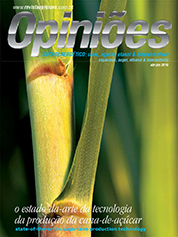Irene Maria Gatti de Almeida
Scientific Researcher - Bacteriologist at Instituto Biológico
Op-AA-24
Bacterial diseases in sugarcane
In Brazil, sugarcane has ranked highly in the social-economic scenario ever since the country’s discovery. At the time, sugar was a rare commodity in Europe, accessible to the elite, and a product of high commercial value. The crop was brought to the New World, where it developed very well, becoming a source of much wealth for Portugal.
However, with the introduction of this monocul-ture, phytosanitary problems also arose, with the direct utilization of imported seedlings in commercial plantations. Thus, several epidemics were registered, whose occurrences were resolved by replacing varieties with other more resistant ones. The first such epidemic occurred in 1863, in the State of Bahia.
The disease called Leaf Scald (caused by Xanthomonas axonopodis pv. vasculorum) resulted in such huge losses, especially in the production of sugar, that a German scientist was brought to Brazil specifically to study the disease. It was the first bacterial disease in plants described in the world, at a time when nobody even thought of bacteria as the cause of disease in plants.
In Brazil, apart from the Leaf Scald epidemic, other occurrences should be mentioned, such as the Mosaic disease (1920-1930), the Culmicolous Smut disease (decades of 1940 to 1980), Rust (decade of 1980) and the Yellow Leaf disease (decade of 1990). Diseases are very important in sugarcane because they cause decay in plant varieties, making it necessary to periodically replace them.
One should emphasize that of the four most important diseases affecting the crop in the world, two are caused by bacteria: Leaf Scald (whose causing agent is Xanthomonas albilineans) and the Ratoon Stunting Disease (caused by Leifsonia xyli subsp. xyli). Apart from the above mentioned bacterial diseases, there is the Red Stripe disease, which causes red stripes on leaves and plants’ top rot and is caused by Acidovorax avenae subsp. Avenae; the Mottled Stripe disease (caused by Herbaspirillum rubrisubalbicans), found only in the State of Pernambuco in variety B4362, causing red stripes on leaves; the Bacterial Stripe disease, whose causing agent is Pseudomonas syringae pv. syringae, that causes reddish stripes on leaves.
All these diseases have been reported in our country. The Xanthomonas sacchari bacterium has also been iso-lated on plants with symptoms of Leaf Scald. The identification of the causing agents of diseases should not only be based on the symptomatology shown by the host, given that different pathogenic agents (such as viruses, fungi, nematodes, and insects) or even nutritional imbalances or pythotoxicity may bring about similar symptoms.
Furthermore, different bac-erial genera and species may cause the same type of symptom and a same bacterium may cause more than one type of symptom. The correct identification of pathogenic agents is also important for the “developmentalists”, who work on obtaining new varieties, many of which with excellent agronomic characteristics, albeit more susceptible.
Diseases that in the past were important, such as Culmicolous Smut, Rust, Mosaic, and Leaf Scald, nowadays only do not represent danger for the crop because most varieties used are resistant and/or tolerant.The main disease control method is to know-ingly plant healthy seedlings. Currently, most of the seedlings that will comprise a basic nursery are produced in labs, by cultivating meristems, a process that warrants better quality, especially with respect to size standardization and health assuredness.
Using resistant varieties is also important. Proper soil preparation, the elimination of weeds and crop residues are also prac-tices to be considered, especially in the case when more susceptible varieties are used. Performing roguing to eliminate sick plants and the frequent cleaning of knives are other recommended measures. Mechanical harvesting can by all means be an important dissemination agent of systemic diseases.
Thermal treatment of seedlings is also important. When the crop was disseminated in the Northeast of the State of São Paulo in the 1970’s, the lack of suf-ficient material to propagate the good quality produced in nurseries resulted in that one resorted to commercial sources, which often lacked the phytosanitary quality required to form new plantations, aggravating the crop’s health problems.
This process is again occurring nowadays, with sugarcane plantations expanding in several states of Brazil to meet the international demand for ethanol fuel. A final aspect to be observed is that there should be a certain degree of variety diversity in plantations. Whenever epidemics occurred in the past, there was always the prevalence of only one or two varieties being used, resulting in greater damages, from which it is difficult to recover.




